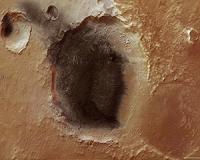 |
Bonn, Germany (SPX) Jun 02, 2010 On 3 June 2010, six 'astronauts' will commence a virtual trip to Mars. Sealed into a cramped container at the Moscow Institute of Biomedical Problems (IBMP) for 520 days, they will experience the rigours and isolation of long-duration spaceflight. This marks the start of the main part of the Mars 500 experiment, and on completion will constitute the longest ever space simulation experiment. Scientists from the German Aerospace Center (DLR) and other German research institutions such as the Charite medical school in Berlin are 'back on board', along with staff from the universities of Erlangen and Bonn. When the hatch closes on 3 June, the six-person crew from Russia, Europe and China will set out on their simulated 520-day journey to the Red Planet. For their virtual outbound leg, they will need 250 days, then have scheduled 30 days for their 'stay' on Mars, after which the crew embarks on its 240-day return journey to Earth. The experiment will take place in a special-purpose test facility at the IMBP in Moscow, where the previous 109-day experiment was conducted in 2009. With the exception of weightlessness and exposure to radiation, in-space conditions will be simulated as realistically as possible. The crew will experience isolation, food and emergency situations of the kind they would encounter on a real long-duration mission. During these 520 days, about 100 tests are planned, covering the fields of psychology, psychophysiology, clinical diagnostics, physiology and microbiology.
Crew needs a high level of autonomy During this long-duration mission, German scientists will be investigating the group dynamics and psychophysiological performance capabilities of the crew. They will also examine how astronauts deal with illness or emergency situations. Another group of researchers will examine how, inside a sealed system, the microbiology and health of a crew develop. The German scientists will also be monitoring the crew's salt and fluid levels, blood pressure regulation and bone metabolism. To investigate physiological questions associated with nutrition, eight German companies are collaborating with the University of Erlangen to provide the team with selected products.
Tests conducted by German scientists during Mars500 + DLR Institute of Aerospace Medicine, Cologne, Dr Petra Rettberg: Microbiology and health in sealed systems + DLR Institute of Aerospace Medicine and the University of Bonn, Dr Natalie B�cker: Bone metabolism + DLR Institute of Aerospace Medicine, Cologne, Dr Luis E.J. Beck: Blood pressure regulation + University of Erlangen, Prof. Jens Titze: Long-term salt and fluid levels in the body + Charite Center for Space Medicine, Berlin, Prof. Hanns-Christian Gunga: Circadian rhythms during long-term isolation + Charite Center for Space Medicine, Berlin, Dr Ulf Gast: Physical fitness through vibration training + Ludwig-Maximilian University, Munich, Prof. Alexander Chouker: Psychophysiological performance capabilities + German Sport University Cologne, Dr Stefan Schneider: Psychophysiological performance capabilities + Johannes Gutenberg University, Mainz, Prof. Dr Wolf Mann: Autonomous emergency medical care for patients
Share This Article With Planet Earth
Related Links German Aerospace Center (DLR) Mars News and Information at MarsDaily.com Lunar Dreams and more
 Volcanic Ash In Meridiani Planum
Volcanic Ash In Meridiani PlanumBonn, Germany (SPX) May 14, 2010 Deposits of volcanic ash colour this view of the Meridiani Planum, captured by High-Resolution Stereo Camera on the Mars Express orbiter operated by the German Aerospace Center (Deutsches Zentrum fur Luft- und Raumfahrt; DLR). Meridiani Planum, a plain at the northern edge of the Southern Highlands of Mars, is located half-way between the volcanic Tharsis Region to the west and the low-lyi ... read more |
|
| The content herein, unless otherwise known to be public domain, are Copyright 1995-2010 - SpaceDaily. AFP and UPI Wire Stories are copyright Agence France-Presse and United Press International. ESA Portal Reports are copyright European Space Agency. All NASA sourced material is public domain. Additional copyrights may apply in whole or part to other bona fide parties. Advertising does not imply endorsement,agreement or approval of any opinions, statements or information provided by SpaceDaily on any Web page published or hosted by SpaceDaily. Privacy Statement |